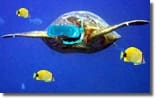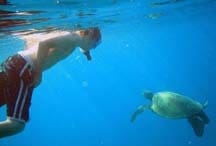How to Snorkel
or Improve Your Snorkeling Technique
Easy Tips on How to Snorkel
Snorkeling is a tool used to access one of nature’s most marvelous realms, and the ocean remains one of the best arenas for exercising our sense of discovery, as well as our bodies. The key to successful snorkeling either on our snorkeling charters or on your own, is relaxation in the water. Try not to overanalyze. Practice will improve your skills and comfort in the water. The tips below assume you already have well fitting equipment.
Your Mask

The strap should only fit snugly at the widest part of your head, towards the top of the back of your head. If it’s at the base of your skull, water may seep in. If water does start seeping in while snorkeling, reach back and see if your strap has slipped down. Don’t tighten the strap beyond “snug,” being too tight causes leaking, as the seal can be broken. The pressure of the water will help seal the mask to your face.
The Snorkel
Attach the snorkel to your diving mask on the left side by using the keeper tab. The snorkel should be positioned just in front of your left ear and the keeper should be in the middle of the tube. Put the mask on, slip the snorkel mouthpiece into your mouth, bite the mouthpiece tabs and wrap your lips around the flexible mouthpiece; lower your head to the water. Adjust the snorkel tube to fit.
Fins
Choose fins that are snug but not too tight. If they hurt or curl your toes especially, you may develop cramps while snorkeling. If they slip off your heels, they’re too big. Better a little big than too small. Remember they will slip on easier when your feet are wet.
Defog
No point going through all the trouble if you can’t see anything (by the way snorkel rental places carry masks with prescription lenses). Products made for defogging seem to work OK (we like the gel products) but anything from spit (or dog drool, which we’ve heard is THEE best), to crushed leaves from particular plants growing near the shore (naupaka in Hawaii), help. We use a small drop of Johnson’s Baby Shampoo, rinsed with ocean water (must use salt water to work well).
Practice Breathing
Practice breathing through the snorkel with your head out of the water before the real thing. Put the mask on your head (wear your strap slightly high on the back of your head and not too tight!), suck it into your face. Put the mouthpiece all the way in your mouth, and close your lips around it. Don’t bite, just rest your teeth on the bite thingies – or your jaw will get really sore.
When ready, practice calm floating in the face down and horizontal position. Having something (scenery, coral, fish, dolphins!, or even your finger tips waving) to focus on helps by distracting you from overanalyzing (worse as we get older).
Mask Tips
Masks should remain reasonably dry on the inside, but they can accidentally fill with water. This usually happens when the strap has slipped down to far. A flooded mask can be easily cleared by raising the head, pulling the lower edge away from the mouth, and simply letting the water drain out. I like to leave a little water in my mask, where it can be swished around for an instant defog.
Snorkel Tips
The same applies to snorkels. A burst of air (similar to a dolphin blow, or saying the word “two”) should clear a flooded snorkel, but breathe in cautiously afterwards just to make sure. If you’re out of air, then simply remove the snorkel from the mouth to breath. It’s helpful to practice deliberately flooding and clearing both mask and snorkel to calmly learn these techniques.
Don’t Tilt Your Head
Tilting your head either forward or backward may cause the tip of the snorkel to enter the water like a straw. You can prevent this from happening by keeping your head straight and horizontally aligned with the rest of your body.
Fins Tips

Practice in the Water (or onboard!)
Once you have mastered using your equipment, practice controlling your movements in the water. You will increase your comfort level as you improve maneuvering abilities and you will also minimize accidental bump-ins with objects in the water such as other snorkelers, reef elements, buoys, etc. It’s easy to lose track of your location with your face in the water, and loss of peripheral vision. Don’t forget to look around for your exit spot or boat every couple of minutes.
Know Your Limitations

A relaxed snorkeler gets more pleasure out of snorkeling and a greater appreciation of the environment. You are also less threatening. When the aquatic wildlife realizes you are not a threat, they resume their normal routine, allowing you to experience their world.
Be Aware
Don’t spread invasive seaweeds. When you snorkel, dive, or anchor, always clean your gear and boat before moving to a new spot. Seaweeds can spread when small pieces of it break off and are carried to a new location.
